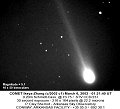|
Summary: In Early
March 2002, Comet Ikeya-Zhang became a naked-eye fuzzball in the evening
sky. It soon brightened to 3rd magnitude and delighted sky watchers
with its remarkable photogenic tail. The comet even had a stunning close
encounter with the Andromeda Galaxy. But all good things must come to
an end. On April 30th, Ikeya-Zhang made its closest approach to Earth
(0.41 AU) and since then has been receding toward the outer solar system.
The fading fuzzball now (on May 2, 2002) glows like a 5th
magnitude star at the limit of naked-eye visibility. Soon it will
be impossible to see without a telescope. So farewell, Ikeya-Zhang!
It was a great show while it lasted.
|
Spaceweather.com
wishes to thank all those who submitted to the Comet Ikeya-Zhang
gallery! The comet is now fading, and the gallery is now closed
to submissions.
|
 |
|
|
Unless
otherwise stated, all images are copyrighted by the photographers.
| |
Photographer, Location,
Date |
Larger images |
Comments |
|
|
Jimmy
Westlake, Rocky Mountains, USA
March 9 |
#1,
#2, #3 |
Jimmy Westlake: "What is it
about the month of March which attracts bright comets?... Saturday
night was spectacular here in the Rockies."
Jimmy's dazzling images were taken on March 9th, using Kodak 400
film. |
|

|
Thad
V'Soske, near Pine Valley, CA, USA
March 9 |
#1,
#2, more |
T. V'Soske: "Despite the light
pollution from San Diego, the Zodiacal light, and thin layers
of clouds, this comet was eye-popping in binoculars and spectacular
through a large refractor!" Photo details: Fuji Superia Extra
800 film and a zoom lens at 200mm and f/3.5. 3 to 5 minute exposures. |
|

|
Igor
Smolic and Krsta Gosic, Wooden Observatory, Yugoslavia
March 9 |
#1 |
Photo details: March 8.74, 2002;
71x10sec unfiltered exposures; S-C, D= 0.28m, f/6.5 + SBIG-ST7
camera; field: 12.8 x 8.4arcmin |
|

|
Dr.
P. Clay Sherrod, Arkansas Sky Observatory, Arkansas, USA
March 8 |
#1,
more |
Clay Sherrod: "Ikeya-Zhang
has brightened significantly in the past two days and has changed
from its distinct spiked tail near the broad head to the very
diffused fan tail shown in the larger image." |
|
|
David
Brown , Bournemouth, UK
March 7 |
#1 |
David Brown: "I live in Dorset,
England (UK) and the comet was about 7 degrees above the horizon.
It is a combination of 10, 10 second exposures using a Starlight
Express MX916 CCD camera on an Orion 8" f/4 Schmidt Newtonian.
The images were acquired on 2002-03-07 at 20:26UT." |
|

|
Dr.
P. Clay Sherrod, Conway, Arkansas, USA
March 6 |
#1,
more |
Clay Sherrod: "The comet was
only 7 degrees off the western horizon when my wife, Patsy and
I got this shot." Photo details: 30 second
exposure with a STV CCD camera on a Meade LX 200 8" telescope
at f/3.75. |
|

|
Jimmy
Westlake, Yampa, Colorado, USA
March 4 |
#1,
#2 |
J. Westlake: "In binoculars
or a small telescope, you can see up to 5 degrees of tail! It
is immersed in the very bright zodiacal light which cuts down
on the contrast, but the view is still excellent." |
|

|
Rolando
Ligustri, Circolo Astrofili Talmassons
Observatory, Italy. March 4 |
#1 |
Photo details: Newtonian reflector
telescope (350 mm diameter f/5); CCD Sbig ST9E; Integration time:
120 seconds. Resolution: 2.5"/pixel. |
|

|
Anton
Spenko and Rok Palcic, Rezmon Observatory, Slovenia
March 4 |
#1,
#2 |
Photo details: Meade 10'' LX 200
telescope, f/4, MX9 CCD camera. |
|

|
Gerald
Rhemann, Germany
March 3 |
#1,
more |
Click
for photo details. |
|

|
Aletti
Andrea and Di Filipo Simone, Varese, Italy
March 3 |
#1 |
Click
for photo details. |
back
to spaceweather.com |










